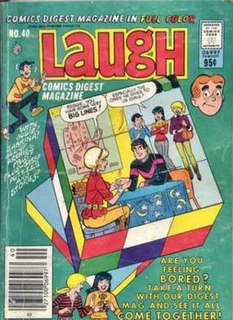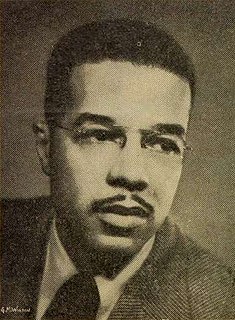
Charlton Comics was an American comic book publishing company that existed from 1945 to 1986, having begun under a different name: T.W.O. Charles Company, in 1940. It was based in Derby, Connecticut. The comic-book line was a division of Charlton Publications, which published magazines, puzzle books and, briefly, books. It had its own distribution company.

Fawcett Comics, a division of Fawcett Publications, was one of several successful comic book publishers during the Golden Age of Comic Books in the 1940s. Its most popular character was Captain Marvel, the alter ego of radio reporter Billy Batson, who transformed into the hero whenever he said the magic word "Shazam!".

Young Love was one of the earliest romance comics titles, published by Crestwood/Prize and later sold to DC Comics.

L. Miller & Son, Ltd. was a British publisher of magazines, comic books, and pulp fiction intended primarily to take advantage of the British ban on importing printed matter. Between 1943 and 1966, the firm published British editions of many American comic books, primarily those of Fawcett Comics. The company is best known for the 1954 creation of Marvelman – a blatant imitation of the Golden Age Captain Marvel – after America's Fawcett Publications capitulated to National Periodicals. L. Miller & Son also published a large line of Western comics — many reprints but also some original titles.

Nyoka the Jungle Girl is a fictional character created for the screen in the 1941 serial Jungle Girl, starring Frances Gifford as Nyoka Meredith. After the initial film, Nyoka appeared in comic books published by Fawcett, Charlton, and AC Comics.

Romance comics is a comics genre depicting strong and close romantic love and its attendant complications such as jealousy, marriage, divorce, betrayal, and heartache. The term is generally associated with an American comic books genre published through the first three decades of the Cold War (1947–1977). Romance comics of the period typically featured dramatic scripts about the love lives of older high school teens and young adults, with accompanying artwork depicting an urban or rural America contemporaneous with publication.

Laugh Comics Digest was a publication of Archie Comics that lasted for 200 issues from August 1974 through April 2005. The title was noteworthy because it was not restricted to any character—it often included reprints of stories featuring the popular spinoff character Sabrina, the Teenage Witch, as well as That Wilkin Boy and Super Duck, and sometimes even included reprints from the very obscure title Cosmo the Merry Martian.

Young Romance is a romantic comic book series created by Joe Simon and Jack Kirby for the Crestwood Publications imprint Prize Comics in 1947. Generally considered the first romance comic, the series ran for 124 consecutive issues under Prize imprint, and a further 84 published by DC Comics after Crestwood stopped producing comics.
Alan Class Comics was a British comics publishing company that operated between 1959 and 1989. The company produced anthology titles, reprinting comics stories from many U.S. publishers of the 1940s to 1960s in a black and white digest size format for a UK audience. During the 1960s and 1970s, these reprints were the main medium through which British children were introduced to American monster and mystery comics, as well as most non-DC or Marvel superheroes.

Sweethearts was a romance comic book series published by Fawcett Publications from October 1948 to 1953, and continued by Charlton Comics from 1954 to 1973. It was the first monthly romance comic book, and a great commercial success. Fawcett followed the title with other monthly romance titles including Life Story (1949), Cowboy Love (1949), and Romantic Secrets (1950).

Western comics is a comics genre usually depicting the American Old West frontier and typically set during the late nineteenth century. The term is generally associated with an American comic books genre published from the late 1940s through the 1950s. Western comics of the period typically featured dramatic scripts about cowboys, gunfighters, lawmen, bounty hunters, outlaws, and Native Americans. Accompanying artwork depicted a rural America populated with such iconic images as guns, cowboy hats, vests, horses, saloons, ranches, and deserts, contemporaneous with the setting.

All-Negro Comics, published in 1947, was a single-issue, small-press American comic book that represents the first known comics magazine written and drawn solely by African-American writers and artists.

Alvin C. Hollingsworth, whose pseudonyms included Alvin Holly, was an American painter and one of the first black artists in comic books.

Elmer Cecil Stoner was an American comics artist and commercial illustrator. Stoner was one of the first African-American comic book artists, and is believed to have created the iconic Mr. Peanut mascot. He produced pencil art for the first issue of Detective Comics, published by National Comics Publications, and worked for a variety of other golden age companies such as Timely Comics, Street & Smith, EC Comics, Fawcett Comics, and Dell Comics. Near the end of his life, Stoner was also a spokesman for Gordon's Gin.

Orrin Cromwell Evans (1902–1971) was a pioneering African-American journalist and comic book publisher. Considered "the first black writer to cover general assignments for a mainstream white newspaper in the United States," he also published All-Negro Comics, the first known comics magazine written and drawn solely by African-American writers and artists.
Steamboat Bill, most commonly as Steamboat, was a fictional character appearing in American comic books published by Fawcett Comics, most commonly in association with the superhero Captain Marvel. The character played the role of valet to both Captain Marvel and his teenaged alter-ego, Billy Batson, and was intended by Captain Marvel co-creator C. C. Beck to appeal to African-American readers. However, protests from African-Americans and other readers concerning Steamboat's racial stereotyping led to the character's disuse after 1945.












